Principles of Developing, Managing and Leading Teams Report
VerifiedAdded on 2023/01/13
|13
|4405
|43
Report
AI Summary
This report examines the principles of developing, managing, and leading individuals and teams, focusing on achieving success within a business context. It uses J Sainsbury plc as a case study to illustrate various theoretical models, including the Belbin model and the Blake Mouton Managerial grid, and their applications in team development and leadership. The report explores practical approaches to effective team management, such as communication and delegation, and strategies for managing team leaders. It also evaluates techniques for assessing current and future team capabilities, including skill matrices and performance reviews, and analyzes the recruitment process. Furthermore, the report covers coaching and mentoring models, methods for monitoring team performance, and practices for enabling high-performing teams, including motivational techniques. The report emphasizes the importance of employee engagement, effective communication, and fairness in creating a successful and productive work environment.
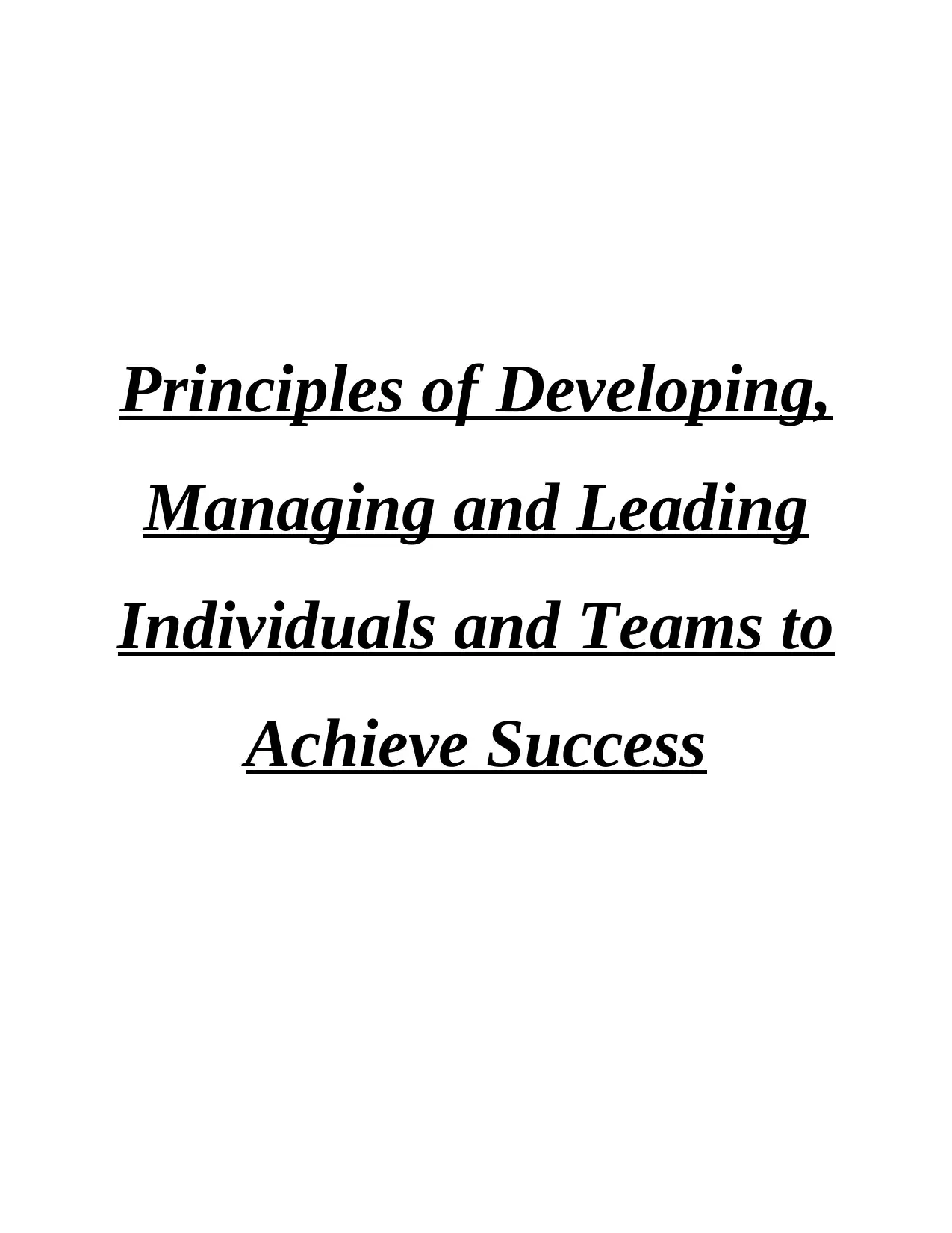
Principles of Developing,
Managing and Leading
Individuals and Teams to
Achieve Success
Managing and Leading
Individuals and Teams to
Achieve Success
Paraphrase This Document
Need a fresh take? Get an instant paraphrase of this document with our AI Paraphraser
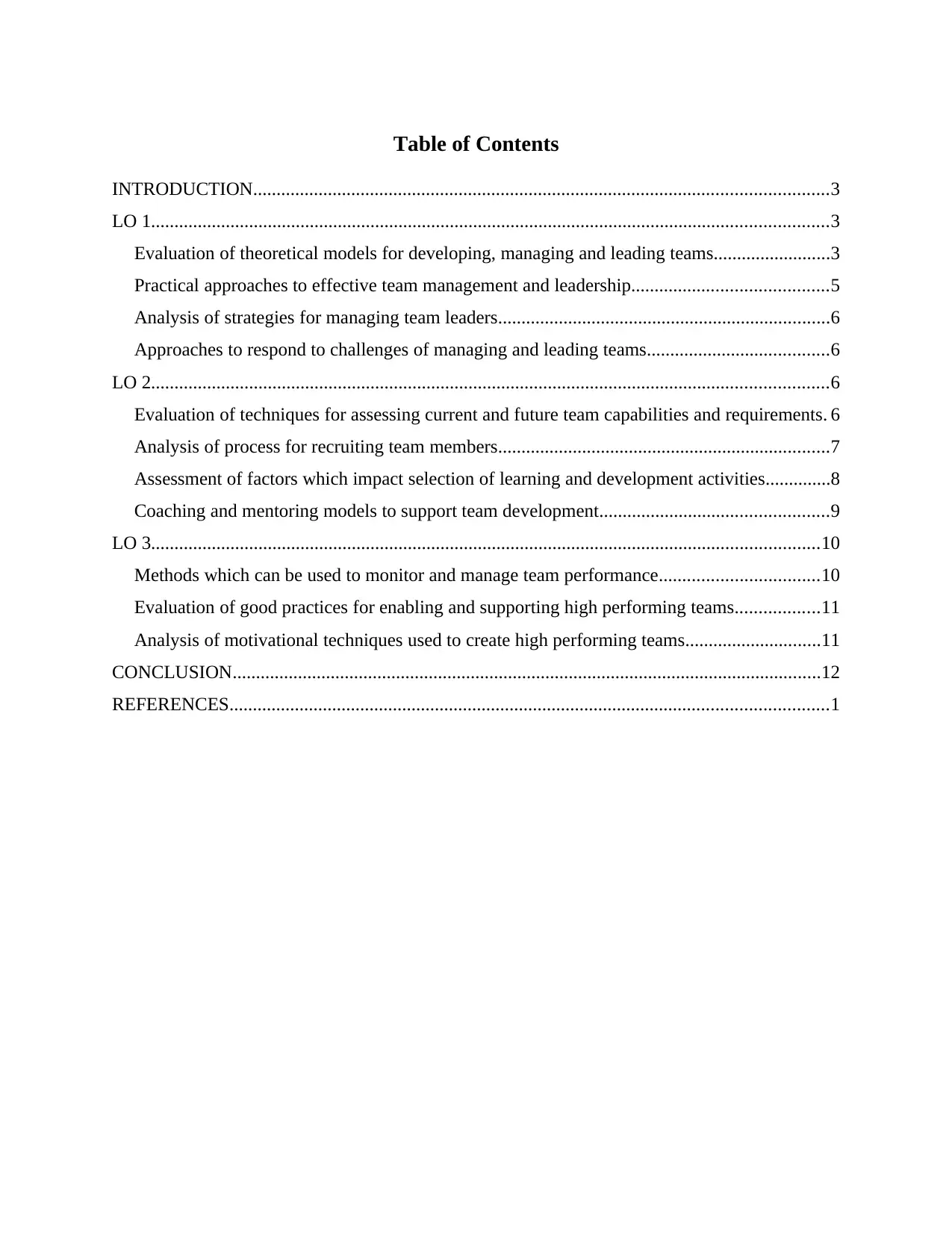
Table of Contents
INTRODUCTION...........................................................................................................................3
LO 1.................................................................................................................................................3
Evaluation of theoretical models for developing, managing and leading teams.........................3
Practical approaches to effective team management and leadership..........................................5
Analysis of strategies for managing team leaders.......................................................................6
Approaches to respond to challenges of managing and leading teams.......................................6
LO 2.................................................................................................................................................6
Evaluation of techniques for assessing current and future team capabilities and requirements. 6
Analysis of process for recruiting team members.......................................................................7
Assessment of factors which impact selection of learning and development activities..............8
Coaching and mentoring models to support team development.................................................9
LO 3...............................................................................................................................................10
Methods which can be used to monitor and manage team performance..................................10
Evaluation of good practices for enabling and supporting high performing teams..................11
Analysis of motivational techniques used to create high performing teams.............................11
CONCLUSION..............................................................................................................................12
REFERENCES................................................................................................................................1
INTRODUCTION...........................................................................................................................3
LO 1.................................................................................................................................................3
Evaluation of theoretical models for developing, managing and leading teams.........................3
Practical approaches to effective team management and leadership..........................................5
Analysis of strategies for managing team leaders.......................................................................6
Approaches to respond to challenges of managing and leading teams.......................................6
LO 2.................................................................................................................................................6
Evaluation of techniques for assessing current and future team capabilities and requirements. 6
Analysis of process for recruiting team members.......................................................................7
Assessment of factors which impact selection of learning and development activities..............8
Coaching and mentoring models to support team development.................................................9
LO 3...............................................................................................................................................10
Methods which can be used to monitor and manage team performance..................................10
Evaluation of good practices for enabling and supporting high performing teams..................11
Analysis of motivational techniques used to create high performing teams.............................11
CONCLUSION..............................................................................................................................12
REFERENCES................................................................................................................................1
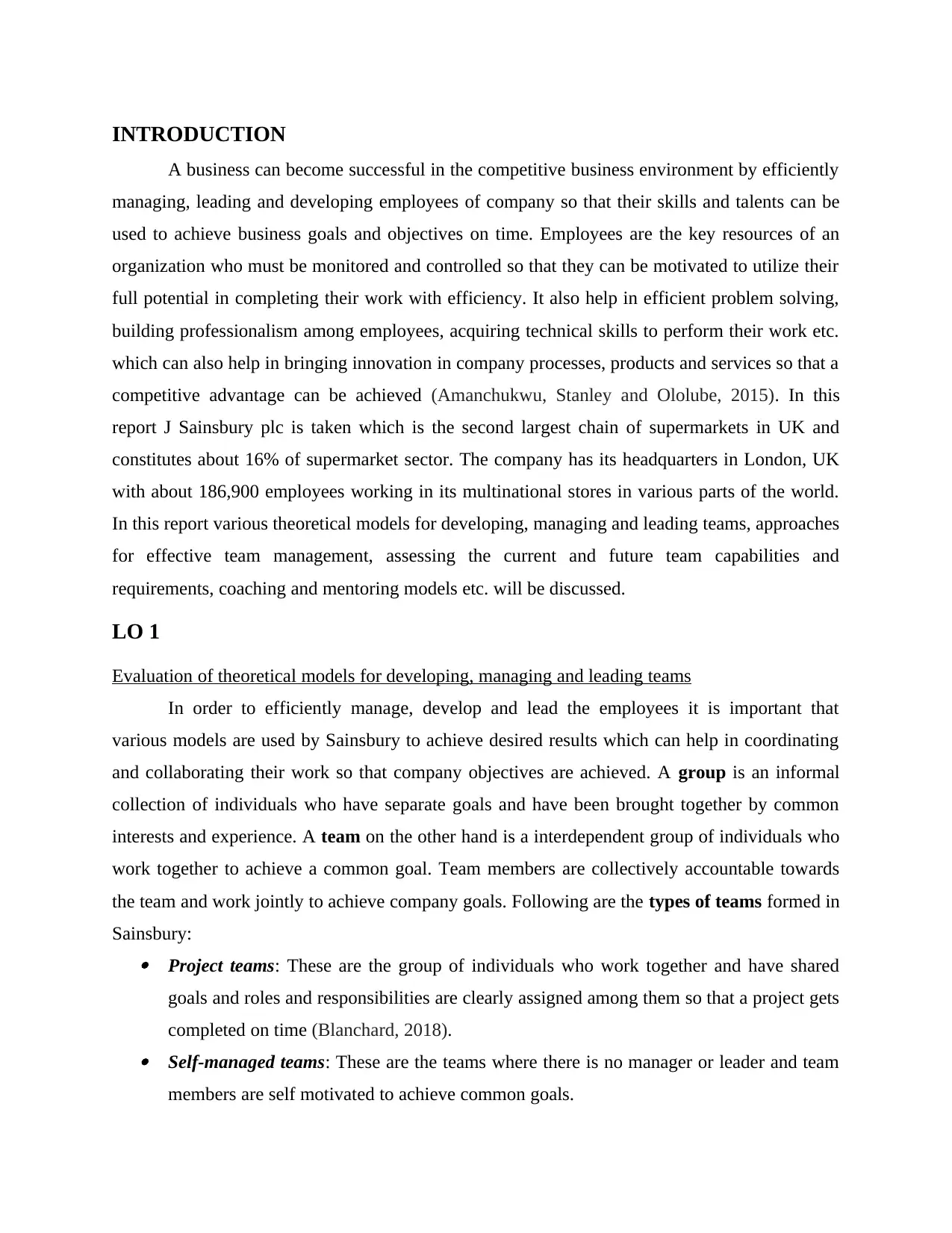
INTRODUCTION
A business can become successful in the competitive business environment by efficiently
managing, leading and developing employees of company so that their skills and talents can be
used to achieve business goals and objectives on time. Employees are the key resources of an
organization who must be monitored and controlled so that they can be motivated to utilize their
full potential in completing their work with efficiency. It also help in efficient problem solving,
building professionalism among employees, acquiring technical skills to perform their work etc.
which can also help in bringing innovation in company processes, products and services so that a
competitive advantage can be achieved (Amanchukwu, Stanley and Ololube, 2015). In this
report J Sainsbury plc is taken which is the second largest chain of supermarkets in UK and
constitutes about 16% of supermarket sector. The company has its headquarters in London, UK
with about 186,900 employees working in its multinational stores in various parts of the world.
In this report various theoretical models for developing, managing and leading teams, approaches
for effective team management, assessing the current and future team capabilities and
requirements, coaching and mentoring models etc. will be discussed.
LO 1
Evaluation of theoretical models for developing, managing and leading teams
In order to efficiently manage, develop and lead the employees it is important that
various models are used by Sainsbury to achieve desired results which can help in coordinating
and collaborating their work so that company objectives are achieved. A group is an informal
collection of individuals who have separate goals and have been brought together by common
interests and experience. A team on the other hand is a interdependent group of individuals who
work together to achieve a common goal. Team members are collectively accountable towards
the team and work jointly to achieve company goals. Following are the types of teams formed in
Sainsbury: Project teams: These are the group of individuals who work together and have shared
goals and roles and responsibilities are clearly assigned among them so that a project gets
completed on time (Blanchard, 2018). Self-managed teams: These are the teams where there is no manager or leader and team
members are self motivated to achieve common goals.
A business can become successful in the competitive business environment by efficiently
managing, leading and developing employees of company so that their skills and talents can be
used to achieve business goals and objectives on time. Employees are the key resources of an
organization who must be monitored and controlled so that they can be motivated to utilize their
full potential in completing their work with efficiency. It also help in efficient problem solving,
building professionalism among employees, acquiring technical skills to perform their work etc.
which can also help in bringing innovation in company processes, products and services so that a
competitive advantage can be achieved (Amanchukwu, Stanley and Ololube, 2015). In this
report J Sainsbury plc is taken which is the second largest chain of supermarkets in UK and
constitutes about 16% of supermarket sector. The company has its headquarters in London, UK
with about 186,900 employees working in its multinational stores in various parts of the world.
In this report various theoretical models for developing, managing and leading teams, approaches
for effective team management, assessing the current and future team capabilities and
requirements, coaching and mentoring models etc. will be discussed.
LO 1
Evaluation of theoretical models for developing, managing and leading teams
In order to efficiently manage, develop and lead the employees it is important that
various models are used by Sainsbury to achieve desired results which can help in coordinating
and collaborating their work so that company objectives are achieved. A group is an informal
collection of individuals who have separate goals and have been brought together by common
interests and experience. A team on the other hand is a interdependent group of individuals who
work together to achieve a common goal. Team members are collectively accountable towards
the team and work jointly to achieve company goals. Following are the types of teams formed in
Sainsbury: Project teams: These are the group of individuals who work together and have shared
goals and roles and responsibilities are clearly assigned among them so that a project gets
completed on time (Blanchard, 2018). Self-managed teams: These are the teams where there is no manager or leader and team
members are self motivated to achieve common goals.
⊘ This is a preview!⊘
Do you want full access?
Subscribe today to unlock all pages.

Trusted by 1+ million students worldwide
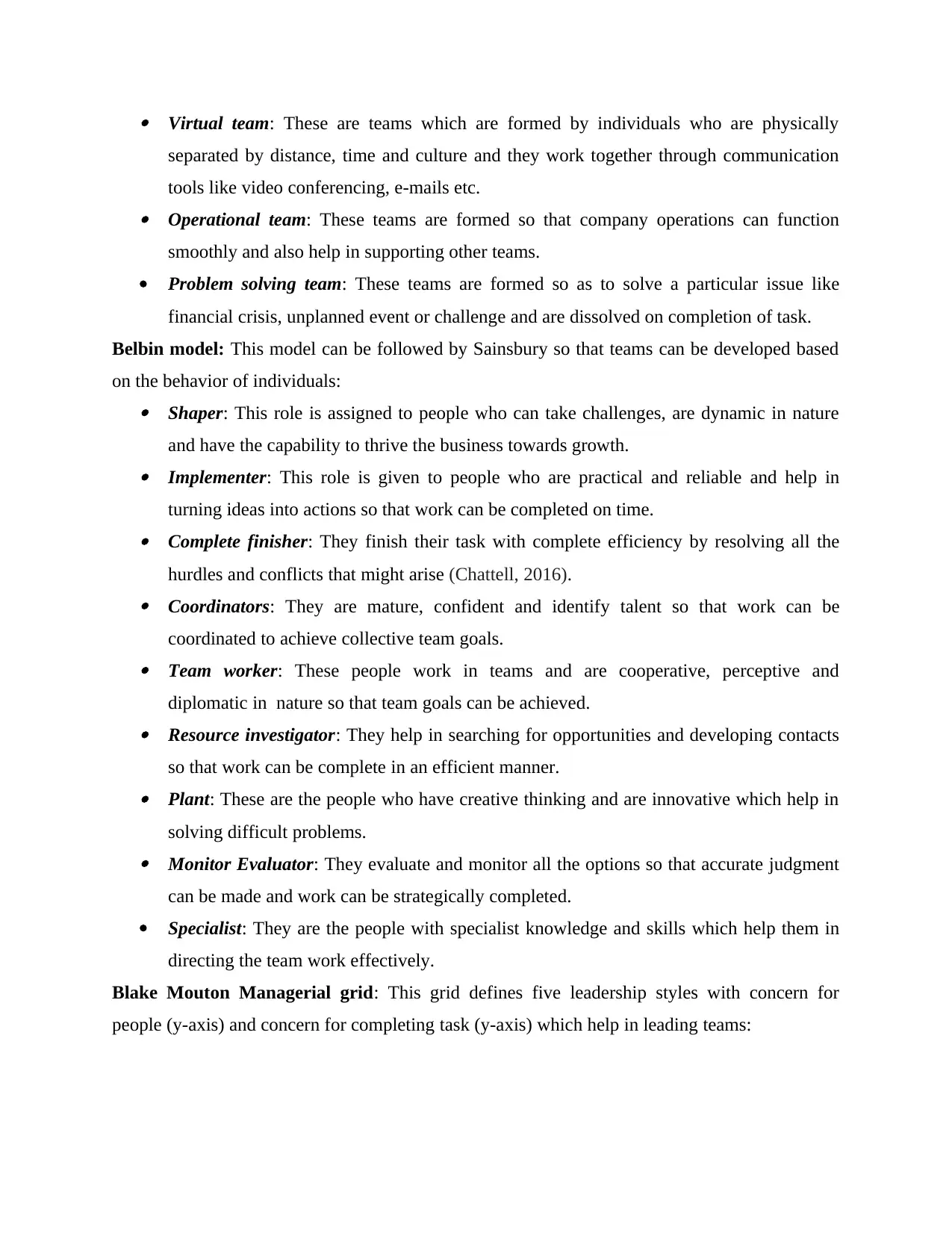
Virtual team: These are teams which are formed by individuals who are physically
separated by distance, time and culture and they work together through communication
tools like video conferencing, e-mails etc. Operational team: These teams are formed so that company operations can function
smoothly and also help in supporting other teams.
Problem solving team: These teams are formed so as to solve a particular issue like
financial crisis, unplanned event or challenge and are dissolved on completion of task.
Belbin model: This model can be followed by Sainsbury so that teams can be developed based
on the behavior of individuals: Shaper: This role is assigned to people who can take challenges, are dynamic in nature
and have the capability to thrive the business towards growth. Implementer: This role is given to people who are practical and reliable and help in
turning ideas into actions so that work can be completed on time. Complete finisher: They finish their task with complete efficiency by resolving all the
hurdles and conflicts that might arise (Chattell, 2016). Coordinators: They are mature, confident and identify talent so that work can be
coordinated to achieve collective team goals. Team worker: These people work in teams and are cooperative, perceptive and
diplomatic in nature so that team goals can be achieved. Resource investigator: They help in searching for opportunities and developing contacts
so that work can be complete in an efficient manner. Plant: These are the people who have creative thinking and are innovative which help in
solving difficult problems. Monitor Evaluator: They evaluate and monitor all the options so that accurate judgment
can be made and work can be strategically completed.
Specialist: They are the people with specialist knowledge and skills which help them in
directing the team work effectively.
Blake Mouton Managerial grid: This grid defines five leadership styles with concern for
people (y-axis) and concern for completing task (y-axis) which help in leading teams:
separated by distance, time and culture and they work together through communication
tools like video conferencing, e-mails etc. Operational team: These teams are formed so that company operations can function
smoothly and also help in supporting other teams.
Problem solving team: These teams are formed so as to solve a particular issue like
financial crisis, unplanned event or challenge and are dissolved on completion of task.
Belbin model: This model can be followed by Sainsbury so that teams can be developed based
on the behavior of individuals: Shaper: This role is assigned to people who can take challenges, are dynamic in nature
and have the capability to thrive the business towards growth. Implementer: This role is given to people who are practical and reliable and help in
turning ideas into actions so that work can be completed on time. Complete finisher: They finish their task with complete efficiency by resolving all the
hurdles and conflicts that might arise (Chattell, 2016). Coordinators: They are mature, confident and identify talent so that work can be
coordinated to achieve collective team goals. Team worker: These people work in teams and are cooperative, perceptive and
diplomatic in nature so that team goals can be achieved. Resource investigator: They help in searching for opportunities and developing contacts
so that work can be complete in an efficient manner. Plant: These are the people who have creative thinking and are innovative which help in
solving difficult problems. Monitor Evaluator: They evaluate and monitor all the options so that accurate judgment
can be made and work can be strategically completed.
Specialist: They are the people with specialist knowledge and skills which help them in
directing the team work effectively.
Blake Mouton Managerial grid: This grid defines five leadership styles with concern for
people (y-axis) and concern for completing task (y-axis) which help in leading teams:
Paraphrase This Document
Need a fresh take? Get an instant paraphrase of this document with our AI Paraphraser
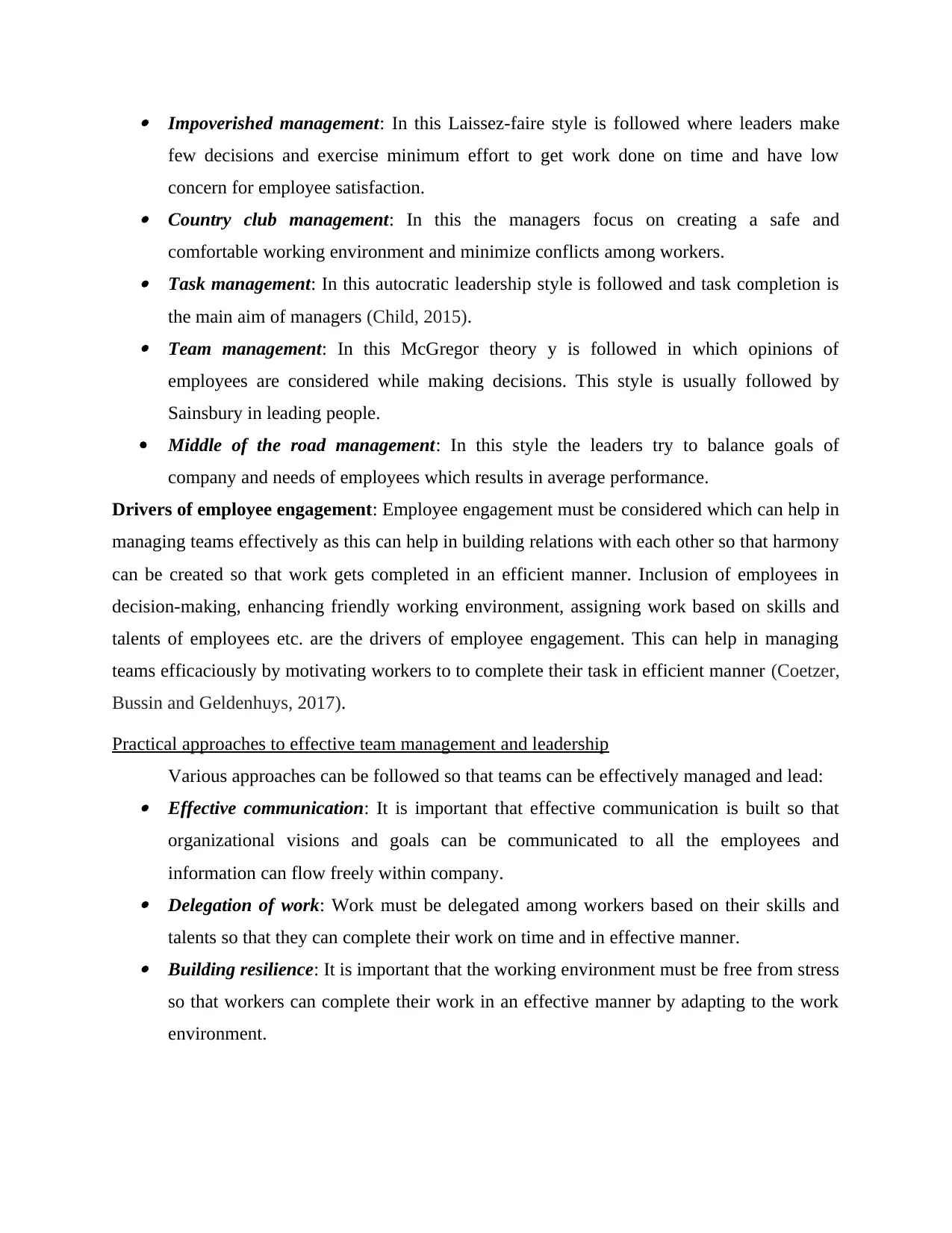
Impoverished management: In this Laissez-faire style is followed where leaders make
few decisions and exercise minimum effort to get work done on time and have low
concern for employee satisfaction. Country club management: In this the managers focus on creating a safe and
comfortable working environment and minimize conflicts among workers. Task management: In this autocratic leadership style is followed and task completion is
the main aim of managers (Child, 2015). Team management: In this McGregor theory y is followed in which opinions of
employees are considered while making decisions. This style is usually followed by
Sainsbury in leading people.
Middle of the road management: In this style the leaders try to balance goals of
company and needs of employees which results in average performance.
Drivers of employee engagement: Employee engagement must be considered which can help in
managing teams effectively as this can help in building relations with each other so that harmony
can be created so that work gets completed in an efficient manner. Inclusion of employees in
decision-making, enhancing friendly working environment, assigning work based on skills and
talents of employees etc. are the drivers of employee engagement. This can help in managing
teams efficaciously by motivating workers to to complete their task in efficient manner (Coetzer,
Bussin and Geldenhuys, 2017).
Practical approaches to effective team management and leadership
Various approaches can be followed so that teams can be effectively managed and lead: Effective communication: It is important that effective communication is built so that
organizational visions and goals can be communicated to all the employees and
information can flow freely within company. Delegation of work: Work must be delegated among workers based on their skills and
talents so that they can complete their work on time and in effective manner. Building resilience: It is important that the working environment must be free from stress
so that workers can complete their work in an effective manner by adapting to the work
environment.
few decisions and exercise minimum effort to get work done on time and have low
concern for employee satisfaction. Country club management: In this the managers focus on creating a safe and
comfortable working environment and minimize conflicts among workers. Task management: In this autocratic leadership style is followed and task completion is
the main aim of managers (Child, 2015). Team management: In this McGregor theory y is followed in which opinions of
employees are considered while making decisions. This style is usually followed by
Sainsbury in leading people.
Middle of the road management: In this style the leaders try to balance goals of
company and needs of employees which results in average performance.
Drivers of employee engagement: Employee engagement must be considered which can help in
managing teams effectively as this can help in building relations with each other so that harmony
can be created so that work gets completed in an efficient manner. Inclusion of employees in
decision-making, enhancing friendly working environment, assigning work based on skills and
talents of employees etc. are the drivers of employee engagement. This can help in managing
teams efficaciously by motivating workers to to complete their task in efficient manner (Coetzer,
Bussin and Geldenhuys, 2017).
Practical approaches to effective team management and leadership
Various approaches can be followed so that teams can be effectively managed and lead: Effective communication: It is important that effective communication is built so that
organizational visions and goals can be communicated to all the employees and
information can flow freely within company. Delegation of work: Work must be delegated among workers based on their skills and
talents so that they can complete their work on time and in effective manner. Building resilience: It is important that the working environment must be free from stress
so that workers can complete their work in an effective manner by adapting to the work
environment.
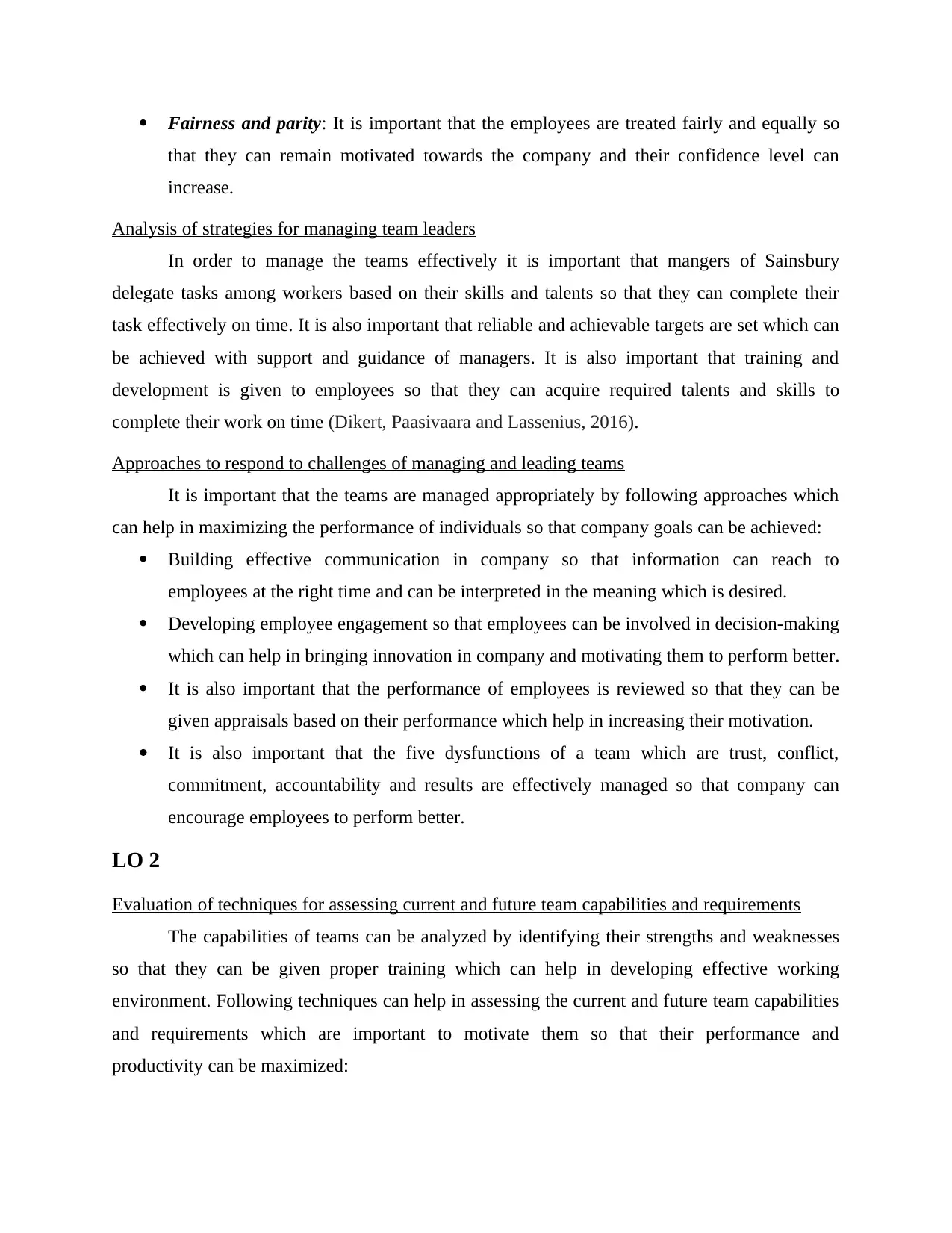
Fairness and parity: It is important that the employees are treated fairly and equally so
that they can remain motivated towards the company and their confidence level can
increase.
Analysis of strategies for managing team leaders
In order to manage the teams effectively it is important that mangers of Sainsbury
delegate tasks among workers based on their skills and talents so that they can complete their
task effectively on time. It is also important that reliable and achievable targets are set which can
be achieved with support and guidance of managers. It is also important that training and
development is given to employees so that they can acquire required talents and skills to
complete their work on time (Dikert, Paasivaara and Lassenius, 2016).
Approaches to respond to challenges of managing and leading teams
It is important that the teams are managed appropriately by following approaches which
can help in maximizing the performance of individuals so that company goals can be achieved:
Building effective communication in company so that information can reach to
employees at the right time and can be interpreted in the meaning which is desired.
Developing employee engagement so that employees can be involved in decision-making
which can help in bringing innovation in company and motivating them to perform better.
It is also important that the performance of employees is reviewed so that they can be
given appraisals based on their performance which help in increasing their motivation.
It is also important that the five dysfunctions of a team which are trust, conflict,
commitment, accountability and results are effectively managed so that company can
encourage employees to perform better.
LO 2
Evaluation of techniques for assessing current and future team capabilities and requirements
The capabilities of teams can be analyzed by identifying their strengths and weaknesses
so that they can be given proper training which can help in developing effective working
environment. Following techniques can help in assessing the current and future team capabilities
and requirements which are important to motivate them so that their performance and
productivity can be maximized:
that they can remain motivated towards the company and their confidence level can
increase.
Analysis of strategies for managing team leaders
In order to manage the teams effectively it is important that mangers of Sainsbury
delegate tasks among workers based on their skills and talents so that they can complete their
task effectively on time. It is also important that reliable and achievable targets are set which can
be achieved with support and guidance of managers. It is also important that training and
development is given to employees so that they can acquire required talents and skills to
complete their work on time (Dikert, Paasivaara and Lassenius, 2016).
Approaches to respond to challenges of managing and leading teams
It is important that the teams are managed appropriately by following approaches which
can help in maximizing the performance of individuals so that company goals can be achieved:
Building effective communication in company so that information can reach to
employees at the right time and can be interpreted in the meaning which is desired.
Developing employee engagement so that employees can be involved in decision-making
which can help in bringing innovation in company and motivating them to perform better.
It is also important that the performance of employees is reviewed so that they can be
given appraisals based on their performance which help in increasing their motivation.
It is also important that the five dysfunctions of a team which are trust, conflict,
commitment, accountability and results are effectively managed so that company can
encourage employees to perform better.
LO 2
Evaluation of techniques for assessing current and future team capabilities and requirements
The capabilities of teams can be analyzed by identifying their strengths and weaknesses
so that they can be given proper training which can help in developing effective working
environment. Following techniques can help in assessing the current and future team capabilities
and requirements which are important to motivate them so that their performance and
productivity can be maximized:
⊘ This is a preview!⊘
Do you want full access?
Subscribe today to unlock all pages.

Trusted by 1+ million students worldwide
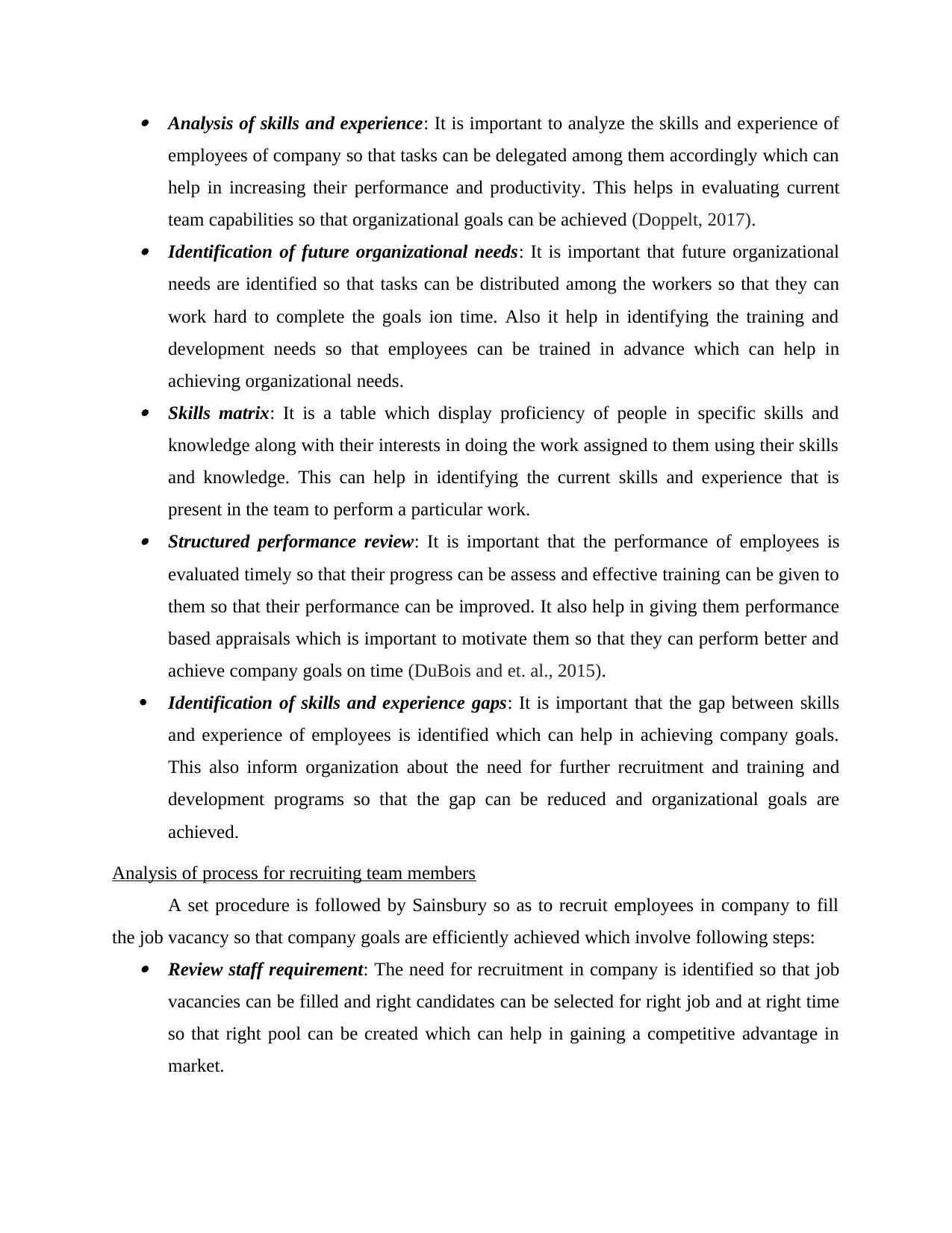
Analysis of skills and experience: It is important to analyze the skills and experience of
employees of company so that tasks can be delegated among them accordingly which can
help in increasing their performance and productivity. This helps in evaluating current
team capabilities so that organizational goals can be achieved (Doppelt, 2017). Identification of future organizational needs: It is important that future organizational
needs are identified so that tasks can be distributed among the workers so that they can
work hard to complete the goals ion time. Also it help in identifying the training and
development needs so that employees can be trained in advance which can help in
achieving organizational needs. Skills matrix: It is a table which display proficiency of people in specific skills and
knowledge along with their interests in doing the work assigned to them using their skills
and knowledge. This can help in identifying the current skills and experience that is
present in the team to perform a particular work. Structured performance review: It is important that the performance of employees is
evaluated timely so that their progress can be assess and effective training can be given to
them so that their performance can be improved. It also help in giving them performance
based appraisals which is important to motivate them so that they can perform better and
achieve company goals on time (DuBois and et. al., 2015).
Identification of skills and experience gaps: It is important that the gap between skills
and experience of employees is identified which can help in achieving company goals.
This also inform organization about the need for further recruitment and training and
development programs so that the gap can be reduced and organizational goals are
achieved.
Analysis of process for recruiting team members
A set procedure is followed by Sainsbury so as to recruit employees in company to fill
the job vacancy so that company goals are efficiently achieved which involve following steps: Review staff requirement: The need for recruitment in company is identified so that job
vacancies can be filled and right candidates can be selected for right job and at right time
so that right pool can be created which can help in gaining a competitive advantage in
market.
employees of company so that tasks can be delegated among them accordingly which can
help in increasing their performance and productivity. This helps in evaluating current
team capabilities so that organizational goals can be achieved (Doppelt, 2017). Identification of future organizational needs: It is important that future organizational
needs are identified so that tasks can be distributed among the workers so that they can
work hard to complete the goals ion time. Also it help in identifying the training and
development needs so that employees can be trained in advance which can help in
achieving organizational needs. Skills matrix: It is a table which display proficiency of people in specific skills and
knowledge along with their interests in doing the work assigned to them using their skills
and knowledge. This can help in identifying the current skills and experience that is
present in the team to perform a particular work. Structured performance review: It is important that the performance of employees is
evaluated timely so that their progress can be assess and effective training can be given to
them so that their performance can be improved. It also help in giving them performance
based appraisals which is important to motivate them so that they can perform better and
achieve company goals on time (DuBois and et. al., 2015).
Identification of skills and experience gaps: It is important that the gap between skills
and experience of employees is identified which can help in achieving company goals.
This also inform organization about the need for further recruitment and training and
development programs so that the gap can be reduced and organizational goals are
achieved.
Analysis of process for recruiting team members
A set procedure is followed by Sainsbury so as to recruit employees in company to fill
the job vacancy so that company goals are efficiently achieved which involve following steps: Review staff requirement: The need for recruitment in company is identified so that job
vacancies can be filled and right candidates can be selected for right job and at right time
so that right pool can be created which can help in gaining a competitive advantage in
market.
Paraphrase This Document
Need a fresh take? Get an instant paraphrase of this document with our AI Paraphraser
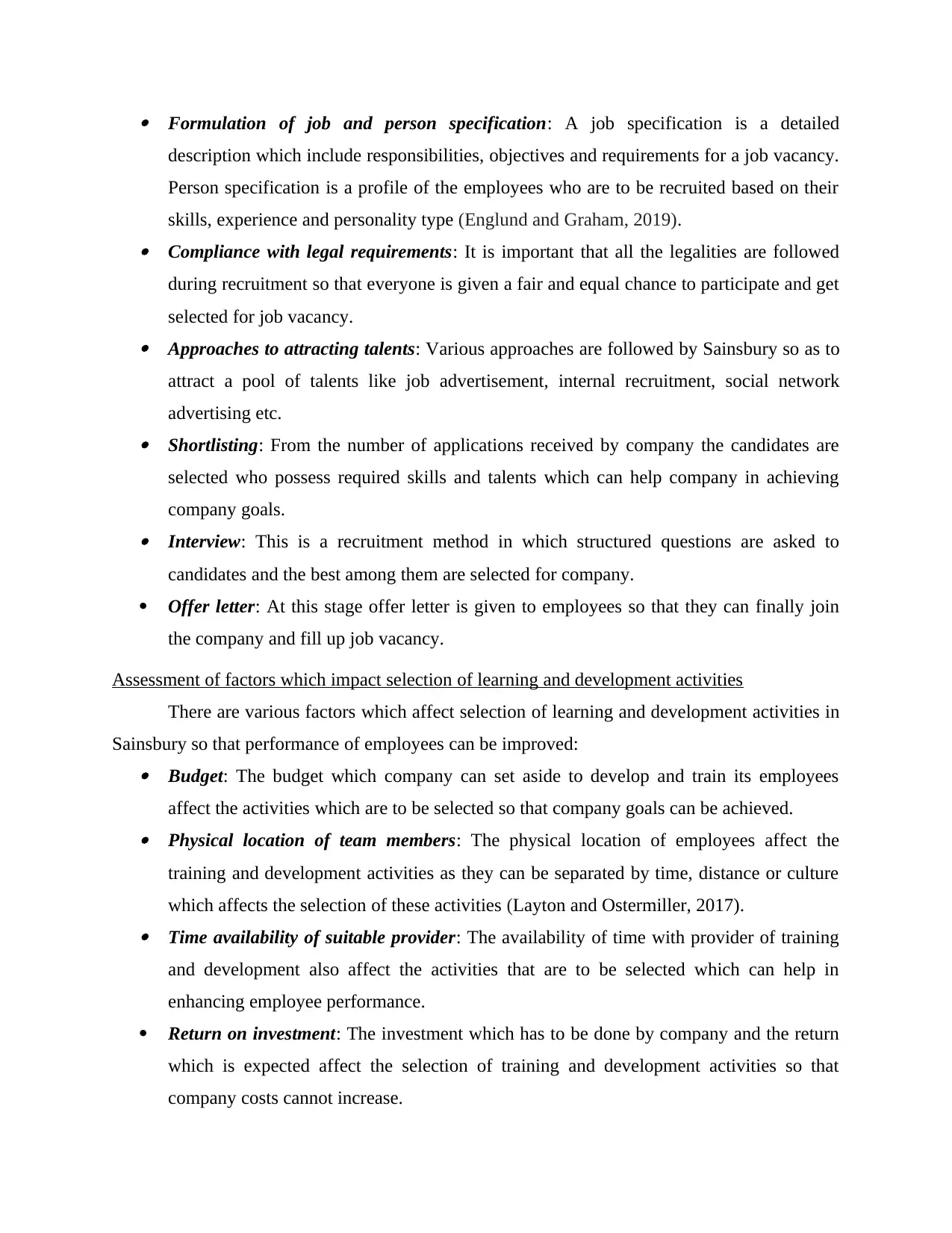
Formulation of job and person specification: A job specification is a detailed
description which include responsibilities, objectives and requirements for a job vacancy.
Person specification is a profile of the employees who are to be recruited based on their
skills, experience and personality type (Englund and Graham, 2019). Compliance with legal requirements: It is important that all the legalities are followed
during recruitment so that everyone is given a fair and equal chance to participate and get
selected for job vacancy. Approaches to attracting talents: Various approaches are followed by Sainsbury so as to
attract a pool of talents like job advertisement, internal recruitment, social network
advertising etc. Shortlisting: From the number of applications received by company the candidates are
selected who possess required skills and talents which can help company in achieving
company goals. Interview: This is a recruitment method in which structured questions are asked to
candidates and the best among them are selected for company.
Offer letter: At this stage offer letter is given to employees so that they can finally join
the company and fill up job vacancy.
Assessment of factors which impact selection of learning and development activities
There are various factors which affect selection of learning and development activities in
Sainsbury so that performance of employees can be improved: Budget: The budget which company can set aside to develop and train its employees
affect the activities which are to be selected so that company goals can be achieved. Physical location of team members: The physical location of employees affect the
training and development activities as they can be separated by time, distance or culture
which affects the selection of these activities (Layton and Ostermiller, 2017). Time availability of suitable provider: The availability of time with provider of training
and development also affect the activities that are to be selected which can help in
enhancing employee performance.
Return on investment: The investment which has to be done by company and the return
which is expected affect the selection of training and development activities so that
company costs cannot increase.
description which include responsibilities, objectives and requirements for a job vacancy.
Person specification is a profile of the employees who are to be recruited based on their
skills, experience and personality type (Englund and Graham, 2019). Compliance with legal requirements: It is important that all the legalities are followed
during recruitment so that everyone is given a fair and equal chance to participate and get
selected for job vacancy. Approaches to attracting talents: Various approaches are followed by Sainsbury so as to
attract a pool of talents like job advertisement, internal recruitment, social network
advertising etc. Shortlisting: From the number of applications received by company the candidates are
selected who possess required skills and talents which can help company in achieving
company goals. Interview: This is a recruitment method in which structured questions are asked to
candidates and the best among them are selected for company.
Offer letter: At this stage offer letter is given to employees so that they can finally join
the company and fill up job vacancy.
Assessment of factors which impact selection of learning and development activities
There are various factors which affect selection of learning and development activities in
Sainsbury so that performance of employees can be improved: Budget: The budget which company can set aside to develop and train its employees
affect the activities which are to be selected so that company goals can be achieved. Physical location of team members: The physical location of employees affect the
training and development activities as they can be separated by time, distance or culture
which affects the selection of these activities (Layton and Ostermiller, 2017). Time availability of suitable provider: The availability of time with provider of training
and development also affect the activities that are to be selected which can help in
enhancing employee performance.
Return on investment: The investment which has to be done by company and the return
which is expected affect the selection of training and development activities so that
company costs cannot increase.
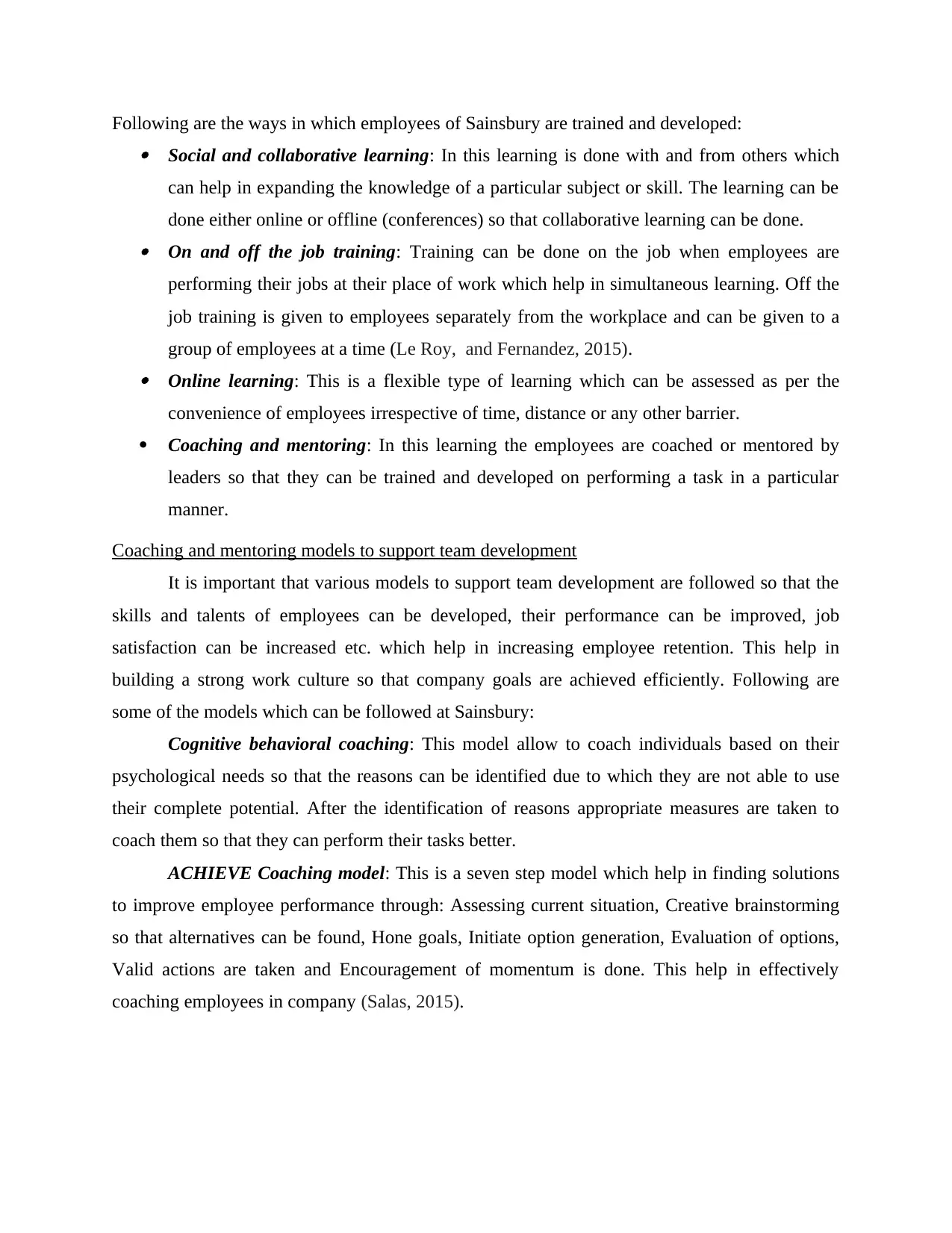
Following are the ways in which employees of Sainsbury are trained and developed: Social and collaborative learning: In this learning is done with and from others which
can help in expanding the knowledge of a particular subject or skill. The learning can be
done either online or offline (conferences) so that collaborative learning can be done. On and off the job training: Training can be done on the job when employees are
performing their jobs at their place of work which help in simultaneous learning. Off the
job training is given to employees separately from the workplace and can be given to a
group of employees at a time (Le Roy, and Fernandez, 2015). Online learning: This is a flexible type of learning which can be assessed as per the
convenience of employees irrespective of time, distance or any other barrier.
Coaching and mentoring: In this learning the employees are coached or mentored by
leaders so that they can be trained and developed on performing a task in a particular
manner.
Coaching and mentoring models to support team development
It is important that various models to support team development are followed so that the
skills and talents of employees can be developed, their performance can be improved, job
satisfaction can be increased etc. which help in increasing employee retention. This help in
building a strong work culture so that company goals are achieved efficiently. Following are
some of the models which can be followed at Sainsbury:
Cognitive behavioral coaching: This model allow to coach individuals based on their
psychological needs so that the reasons can be identified due to which they are not able to use
their complete potential. After the identification of reasons appropriate measures are taken to
coach them so that they can perform their tasks better.
ACHIEVE Coaching model: This is a seven step model which help in finding solutions
to improve employee performance through: Assessing current situation, Creative brainstorming
so that alternatives can be found, Hone goals, Initiate option generation, Evaluation of options,
Valid actions are taken and Encouragement of momentum is done. This help in effectively
coaching employees in company (Salas, 2015).
can help in expanding the knowledge of a particular subject or skill. The learning can be
done either online or offline (conferences) so that collaborative learning can be done. On and off the job training: Training can be done on the job when employees are
performing their jobs at their place of work which help in simultaneous learning. Off the
job training is given to employees separately from the workplace and can be given to a
group of employees at a time (Le Roy, and Fernandez, 2015). Online learning: This is a flexible type of learning which can be assessed as per the
convenience of employees irrespective of time, distance or any other barrier.
Coaching and mentoring: In this learning the employees are coached or mentored by
leaders so that they can be trained and developed on performing a task in a particular
manner.
Coaching and mentoring models to support team development
It is important that various models to support team development are followed so that the
skills and talents of employees can be developed, their performance can be improved, job
satisfaction can be increased etc. which help in increasing employee retention. This help in
building a strong work culture so that company goals are achieved efficiently. Following are
some of the models which can be followed at Sainsbury:
Cognitive behavioral coaching: This model allow to coach individuals based on their
psychological needs so that the reasons can be identified due to which they are not able to use
their complete potential. After the identification of reasons appropriate measures are taken to
coach them so that they can perform their tasks better.
ACHIEVE Coaching model: This is a seven step model which help in finding solutions
to improve employee performance through: Assessing current situation, Creative brainstorming
so that alternatives can be found, Hone goals, Initiate option generation, Evaluation of options,
Valid actions are taken and Encouragement of momentum is done. This help in effectively
coaching employees in company (Salas, 2015).
⊘ This is a preview!⊘
Do you want full access?
Subscribe today to unlock all pages.

Trusted by 1+ million students worldwide
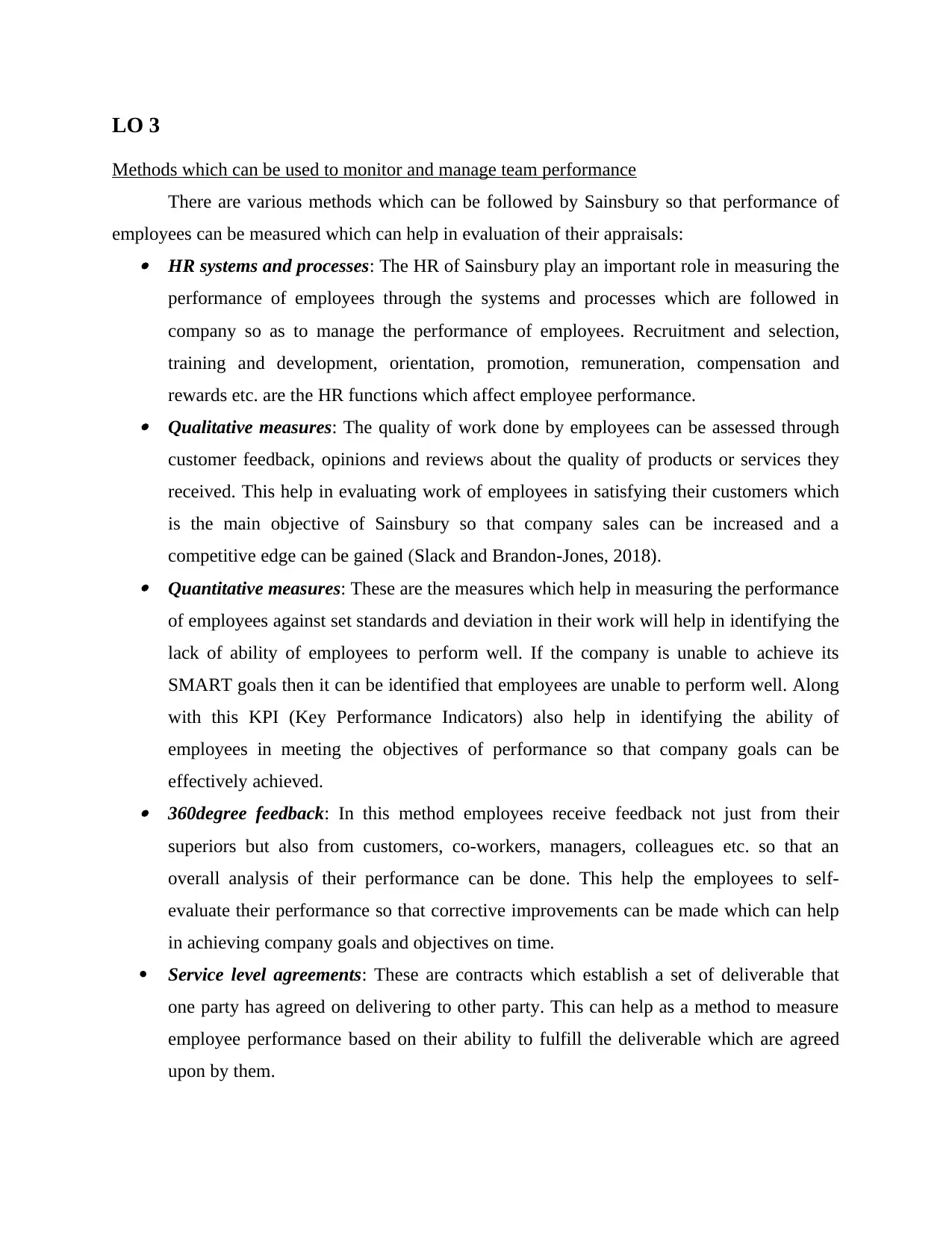
LO 3
Methods which can be used to monitor and manage team performance
There are various methods which can be followed by Sainsbury so that performance of
employees can be measured which can help in evaluation of their appraisals: HR systems and processes: The HR of Sainsbury play an important role in measuring the
performance of employees through the systems and processes which are followed in
company so as to manage the performance of employees. Recruitment and selection,
training and development, orientation, promotion, remuneration, compensation and
rewards etc. are the HR functions which affect employee performance. Qualitative measures: The quality of work done by employees can be assessed through
customer feedback, opinions and reviews about the quality of products or services they
received. This help in evaluating work of employees in satisfying their customers which
is the main objective of Sainsbury so that company sales can be increased and a
competitive edge can be gained (Slack and Brandon-Jones, 2018). Quantitative measures: These are the measures which help in measuring the performance
of employees against set standards and deviation in their work will help in identifying the
lack of ability of employees to perform well. If the company is unable to achieve its
SMART goals then it can be identified that employees are unable to perform well. Along
with this KPI (Key Performance Indicators) also help in identifying the ability of
employees in meeting the objectives of performance so that company goals can be
effectively achieved. 360degree feedback: In this method employees receive feedback not just from their
superiors but also from customers, co-workers, managers, colleagues etc. so that an
overall analysis of their performance can be done. This help the employees to self-
evaluate their performance so that corrective improvements can be made which can help
in achieving company goals and objectives on time.
Service level agreements: These are contracts which establish a set of deliverable that
one party has agreed on delivering to other party. This can help as a method to measure
employee performance based on their ability to fulfill the deliverable which are agreed
upon by them.
Methods which can be used to monitor and manage team performance
There are various methods which can be followed by Sainsbury so that performance of
employees can be measured which can help in evaluation of their appraisals: HR systems and processes: The HR of Sainsbury play an important role in measuring the
performance of employees through the systems and processes which are followed in
company so as to manage the performance of employees. Recruitment and selection,
training and development, orientation, promotion, remuneration, compensation and
rewards etc. are the HR functions which affect employee performance. Qualitative measures: The quality of work done by employees can be assessed through
customer feedback, opinions and reviews about the quality of products or services they
received. This help in evaluating work of employees in satisfying their customers which
is the main objective of Sainsbury so that company sales can be increased and a
competitive edge can be gained (Slack and Brandon-Jones, 2018). Quantitative measures: These are the measures which help in measuring the performance
of employees against set standards and deviation in their work will help in identifying the
lack of ability of employees to perform well. If the company is unable to achieve its
SMART goals then it can be identified that employees are unable to perform well. Along
with this KPI (Key Performance Indicators) also help in identifying the ability of
employees in meeting the objectives of performance so that company goals can be
effectively achieved. 360degree feedback: In this method employees receive feedback not just from their
superiors but also from customers, co-workers, managers, colleagues etc. so that an
overall analysis of their performance can be done. This help the employees to self-
evaluate their performance so that corrective improvements can be made which can help
in achieving company goals and objectives on time.
Service level agreements: These are contracts which establish a set of deliverable that
one party has agreed on delivering to other party. This can help as a method to measure
employee performance based on their ability to fulfill the deliverable which are agreed
upon by them.
Paraphrase This Document
Need a fresh take? Get an instant paraphrase of this document with our AI Paraphraser
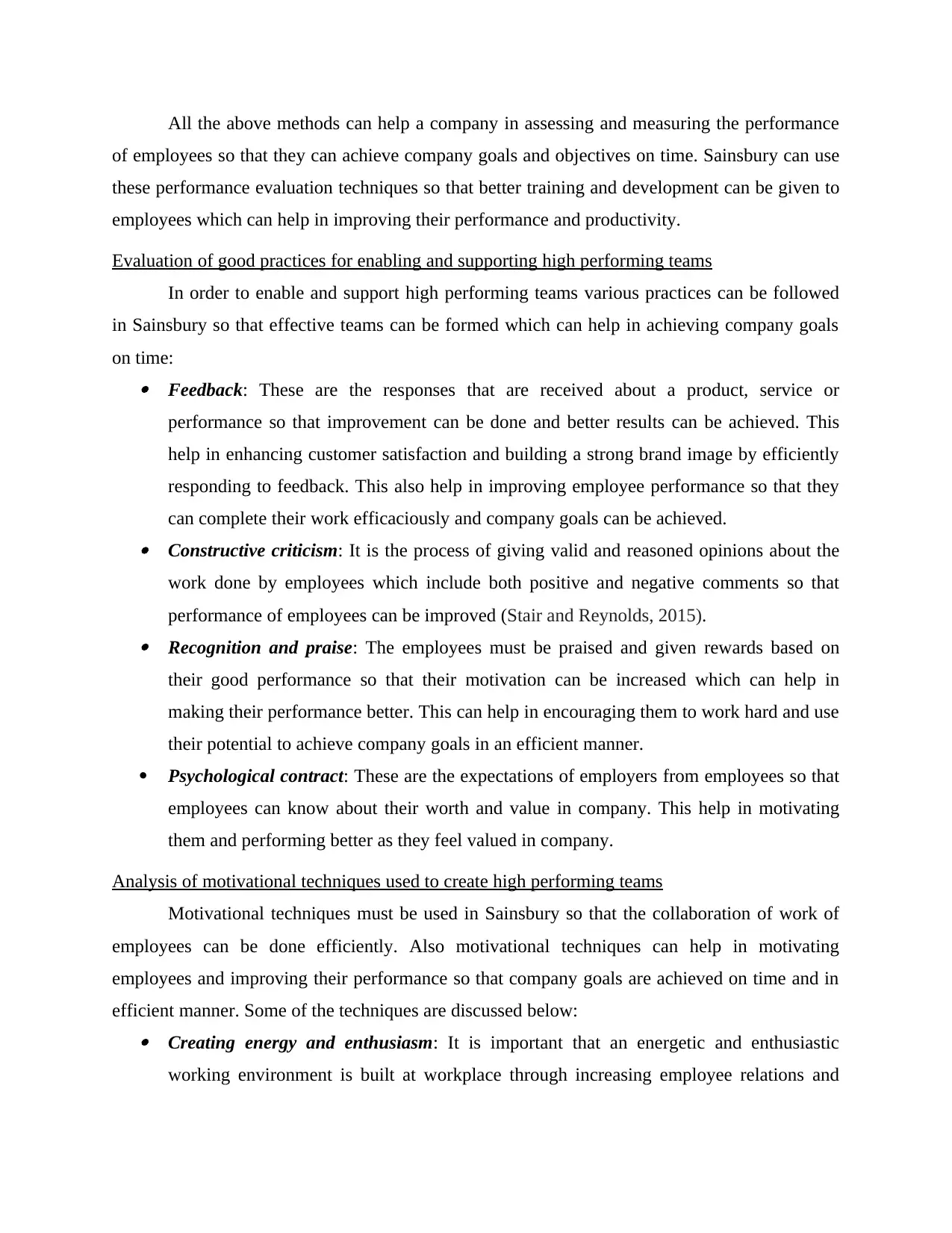
All the above methods can help a company in assessing and measuring the performance
of employees so that they can achieve company goals and objectives on time. Sainsbury can use
these performance evaluation techniques so that better training and development can be given to
employees which can help in improving their performance and productivity.
Evaluation of good practices for enabling and supporting high performing teams
In order to enable and support high performing teams various practices can be followed
in Sainsbury so that effective teams can be formed which can help in achieving company goals
on time: Feedback: These are the responses that are received about a product, service or
performance so that improvement can be done and better results can be achieved. This
help in enhancing customer satisfaction and building a strong brand image by efficiently
responding to feedback. This also help in improving employee performance so that they
can complete their work efficaciously and company goals can be achieved. Constructive criticism: It is the process of giving valid and reasoned opinions about the
work done by employees which include both positive and negative comments so that
performance of employees can be improved (Stair and Reynolds, 2015). Recognition and praise: The employees must be praised and given rewards based on
their good performance so that their motivation can be increased which can help in
making their performance better. This can help in encouraging them to work hard and use
their potential to achieve company goals in an efficient manner.
Psychological contract: These are the expectations of employers from employees so that
employees can know about their worth and value in company. This help in motivating
them and performing better as they feel valued in company.
Analysis of motivational techniques used to create high performing teams
Motivational techniques must be used in Sainsbury so that the collaboration of work of
employees can be done efficiently. Also motivational techniques can help in motivating
employees and improving their performance so that company goals are achieved on time and in
efficient manner. Some of the techniques are discussed below: Creating energy and enthusiasm: It is important that an energetic and enthusiastic
working environment is built at workplace through increasing employee relations and
of employees so that they can achieve company goals and objectives on time. Sainsbury can use
these performance evaluation techniques so that better training and development can be given to
employees which can help in improving their performance and productivity.
Evaluation of good practices for enabling and supporting high performing teams
In order to enable and support high performing teams various practices can be followed
in Sainsbury so that effective teams can be formed which can help in achieving company goals
on time: Feedback: These are the responses that are received about a product, service or
performance so that improvement can be done and better results can be achieved. This
help in enhancing customer satisfaction and building a strong brand image by efficiently
responding to feedback. This also help in improving employee performance so that they
can complete their work efficaciously and company goals can be achieved. Constructive criticism: It is the process of giving valid and reasoned opinions about the
work done by employees which include both positive and negative comments so that
performance of employees can be improved (Stair and Reynolds, 2015). Recognition and praise: The employees must be praised and given rewards based on
their good performance so that their motivation can be increased which can help in
making their performance better. This can help in encouraging them to work hard and use
their potential to achieve company goals in an efficient manner.
Psychological contract: These are the expectations of employers from employees so that
employees can know about their worth and value in company. This help in motivating
them and performing better as they feel valued in company.
Analysis of motivational techniques used to create high performing teams
Motivational techniques must be used in Sainsbury so that the collaboration of work of
employees can be done efficiently. Also motivational techniques can help in motivating
employees and improving their performance so that company goals are achieved on time and in
efficient manner. Some of the techniques are discussed below: Creating energy and enthusiasm: It is important that an energetic and enthusiastic
working environment is built at workplace through increasing employee relations and
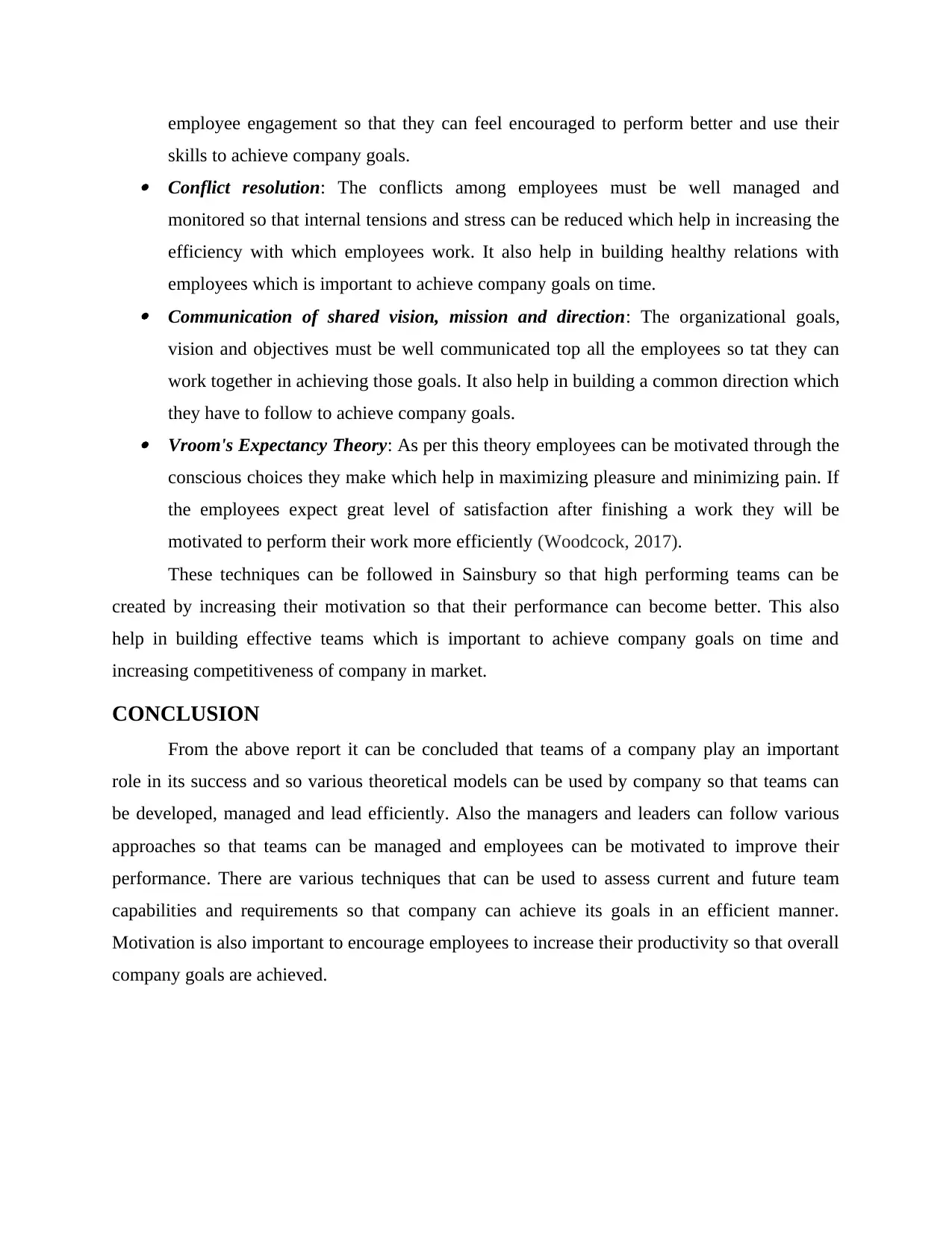
employee engagement so that they can feel encouraged to perform better and use their
skills to achieve company goals. Conflict resolution: The conflicts among employees must be well managed and
monitored so that internal tensions and stress can be reduced which help in increasing the
efficiency with which employees work. It also help in building healthy relations with
employees which is important to achieve company goals on time. Communication of shared vision, mission and direction: The organizational goals,
vision and objectives must be well communicated top all the employees so tat they can
work together in achieving those goals. It also help in building a common direction which
they have to follow to achieve company goals. Vroom's Expectancy Theory: As per this theory employees can be motivated through the
conscious choices they make which help in maximizing pleasure and minimizing pain. If
the employees expect great level of satisfaction after finishing a work they will be
motivated to perform their work more efficiently (Woodcock, 2017).
These techniques can be followed in Sainsbury so that high performing teams can be
created by increasing their motivation so that their performance can become better. This also
help in building effective teams which is important to achieve company goals on time and
increasing competitiveness of company in market.
CONCLUSION
From the above report it can be concluded that teams of a company play an important
role in its success and so various theoretical models can be used by company so that teams can
be developed, managed and lead efficiently. Also the managers and leaders can follow various
approaches so that teams can be managed and employees can be motivated to improve their
performance. There are various techniques that can be used to assess current and future team
capabilities and requirements so that company can achieve its goals in an efficient manner.
Motivation is also important to encourage employees to increase their productivity so that overall
company goals are achieved.
skills to achieve company goals. Conflict resolution: The conflicts among employees must be well managed and
monitored so that internal tensions and stress can be reduced which help in increasing the
efficiency with which employees work. It also help in building healthy relations with
employees which is important to achieve company goals on time. Communication of shared vision, mission and direction: The organizational goals,
vision and objectives must be well communicated top all the employees so tat they can
work together in achieving those goals. It also help in building a common direction which
they have to follow to achieve company goals. Vroom's Expectancy Theory: As per this theory employees can be motivated through the
conscious choices they make which help in maximizing pleasure and minimizing pain. If
the employees expect great level of satisfaction after finishing a work they will be
motivated to perform their work more efficiently (Woodcock, 2017).
These techniques can be followed in Sainsbury so that high performing teams can be
created by increasing their motivation so that their performance can become better. This also
help in building effective teams which is important to achieve company goals on time and
increasing competitiveness of company in market.
CONCLUSION
From the above report it can be concluded that teams of a company play an important
role in its success and so various theoretical models can be used by company so that teams can
be developed, managed and lead efficiently. Also the managers and leaders can follow various
approaches so that teams can be managed and employees can be motivated to improve their
performance. There are various techniques that can be used to assess current and future team
capabilities and requirements so that company can achieve its goals in an efficient manner.
Motivation is also important to encourage employees to increase their productivity so that overall
company goals are achieved.
⊘ This is a preview!⊘
Do you want full access?
Subscribe today to unlock all pages.

Trusted by 1+ million students worldwide
1 out of 13
Related Documents
Your All-in-One AI-Powered Toolkit for Academic Success.
+13062052269
info@desklib.com
Available 24*7 on WhatsApp / Email
![[object Object]](/_next/static/media/star-bottom.7253800d.svg)
Unlock your academic potential
Copyright © 2020–2025 A2Z Services. All Rights Reserved. Developed and managed by ZUCOL.





